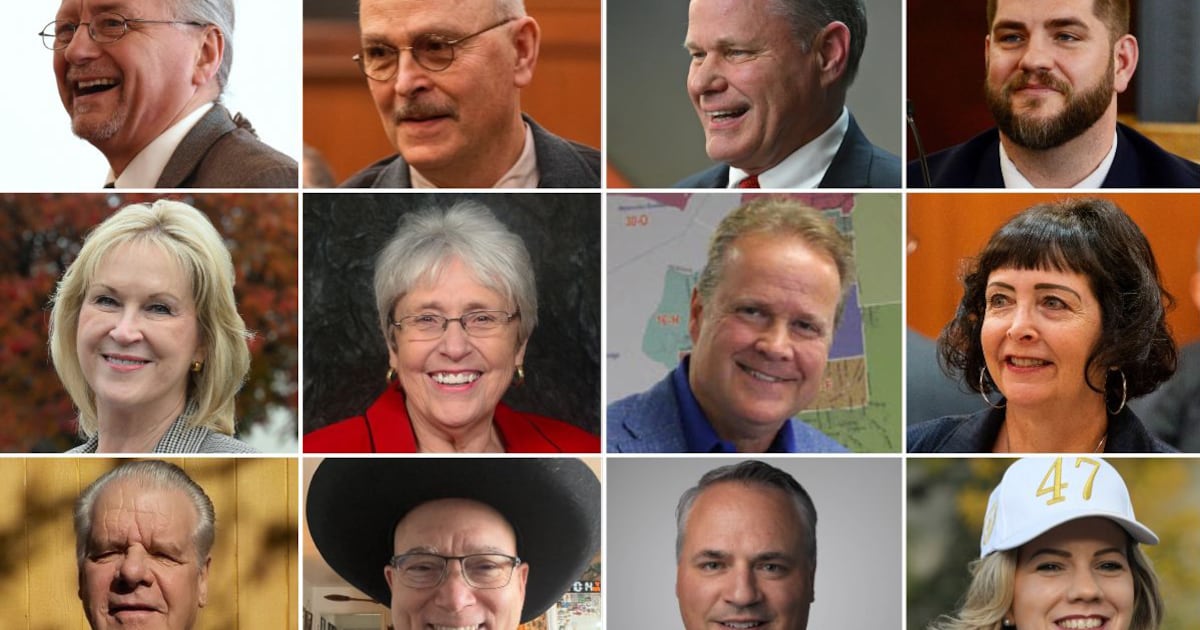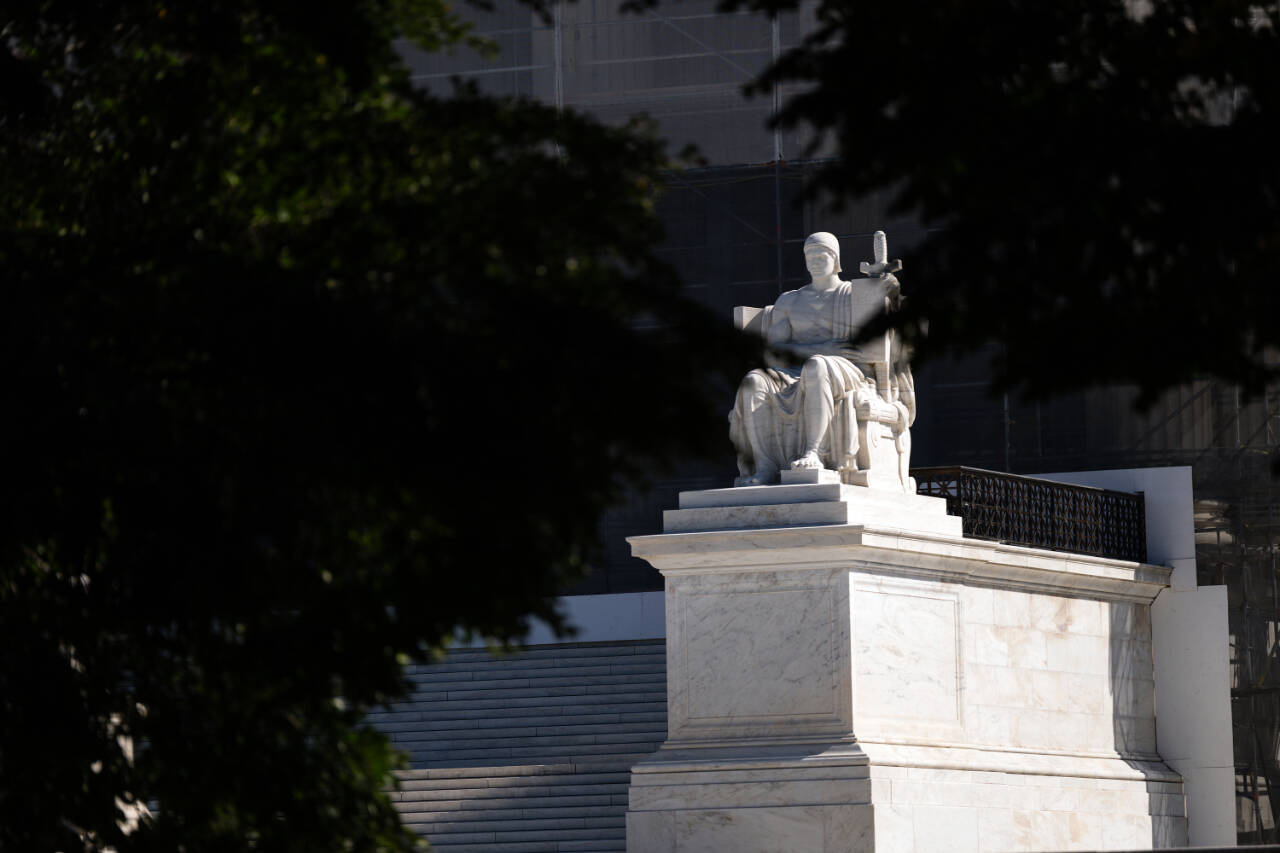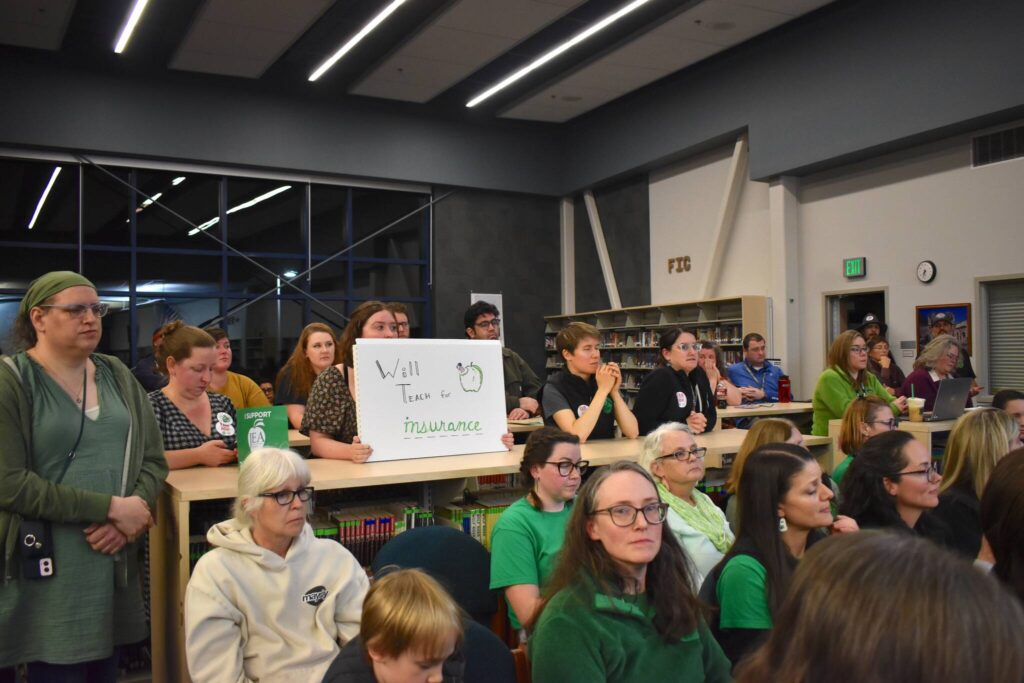The pool of candidates for Alaska governor in the 2026 election includes, top row from left, Tom Begich, Click Bishop, Dave Bronson, Adam Crum; middle row from left, Nancy Dahlstrom, Edna DeVries, Matt Heilala, Shelley Hughes; and bottom row from left, Henry Kroll, James Parkin, Treg Taylor and Bernadette Wilson. (Candidate and ADN photos)
Just under a year before Alaskans head to the polls to pick a new governor, the field of candidates is already crowded.
With 13 candidates — including a dozen Republicans and a single Democrat — and months to go until campaigning heats up in earnest, some in the field have their sights set on the mid-February fundraising deadline, when each will be required to report to the state who had given significant sums to their campaigns.
That could serve as a test for a handful of GOP candidates — who largely share political views and have similar degrees of political experience — to prove that they have the support and money needed to sustain what could become the most expensive gubernatorial campaign in state history.
A large number of contributions can create “social proof,” said Matt Heilala, a podiatrist who is running for governor and has also given contributions to numerous GOP candidates in the past. A too-small number of contributors could be “embarrassing,” he said.
“Any kind of support helps with credibility,” he said.
But fundraising for Republican candidates has not been easy. With so many names in the race, donors who have given money to political hopefuls in the past are remaining on the sidelines, waiting for the field to narrow, candidates say.
“It’s hard with so many people in the race, because it’s such a small state, so people don’t want to offend others, and so they’re staying out of it unless you’ve got good, deep personal relationships,” said candidate Adam Crum, a former revenue commissioner under Gov. Mike Dunleavy, who is termed out from seeking reelection.
“It’s weird, this dynamic. Never had this before in Alaska politics,” Crum said. “It’s one thing to have a lot of candidates, and it’s one thing to have a lot of candidates that have some name recognition or their own kind of base of support,” said Crum.
The Republicans in the race include former Anchorage Mayor Dave Bronson; Lt. Gov. Nancy Dahlstrom; Palmer Sen. Shelley Hughes; former Attorney General Treg Taylor; Crum, the former revenue commissioner; former Labor Commissioner and state Sen. Click Bishop; Matanuska-Susitna Borough Mayor Edna DeVries; Heilala, the podiatrist; businesswoman Bernadette Wilson; fisherman and author Henry Kroll; Palmer resident Bruce Walden; and James Parkin of Angoon.
Amid challenges in fundraising, Crum earlier this week sent out an email in which he blasted Taylor, another veteran of the Dunleavy administration, for hosting a fundraiser in Washington, D.C., that was headlined by attorneys who have openly criticized President Donald Trump.
Taylor is also the only candidate who has had an independent expenditure group form to fundraise on his behalf. Taylor declined interview requests this week.
Trump has yet to weigh on Alaska’s race for governor, as has Dunleavy.
Crum has made it a priority to court Trump’s endorsement, touting a visit to the White House late last month. He will face stiff competition for Trump’s endorsement, if he seeks it. Wilson, a former talk radio host who heads a trash disposal company, earlier this year hired Trump-affiliated campaign consultants. Dahlstrom has previously been endorsed by Trump when she ran for Congress. Bronson got a shout-out from Trump during his Anchorage rally in 2022.
Hughes, who represents Palmer in the Legislature, said she, too, is noticing that many visible donors are “wanting to wait until later” to spend their money in the race.
“I understand that’s why certain candidates are going Outside to try to get a lot of Outside money,” said Hughes. But, she added, “there’s typically a little disdain in this state for outsiders determining how things go here. So I don’t know how well that will fly.”
One GOP candidate said he had not encountered the difficulties shared by others — Bishop, who served 11 years in the Legislature, often in bipartisan coalitions.
Bishop said his fundraisers so far have been “productive.” That’s in part because he draws on a different coalition of supporters from other Republicans, he said, including labor groups.
“That’s no different than when I first ran for the Senate,” he said.
‘Trying to differentiate’
The challenges in fundraising — and navigating a Trump-dominated political party — will shape the coming months for the Republicans in the race.
The Democratic Party so far has fielded a single candidate: former Anchorage state Sen. Tom Begich. He has promised he would drop out of the race if former U.S. Rep. Mary Peltola — a Democrat who lost reelection last year to Begich’s Republican nephew Nick Begich III — enters the governor’s race.
Peltola is not the only candidate still weighing a run. Multiple candidates said this week that they had heard other credible gubernatorial hopefuls could join the GOP field before the June filing deadline.
Tom Begich said the proliferation of GOP candidates has created a contrast between him and the rest of the field and allowed him to spend time talking more about what’s at stake for the state.
“I don’t have to deal with the ‘what about all the other candidates running’ argument, which I think some of the Republicans have to deal with in this race because they’re trying to differentiate themselves,” said Begich.
Amid challenging fundraising, some candidates say they are willing to spend their own money on the race. The cost of an Alaska gubernatorial campaign in the recent past has been measured in the hundreds of thousands of dollars, a far cry from the millions spent on congressional elections. In the previous gubernatorial race in 2022, each of the leading candidates raised between $1.5 million and $2.5 million over the course of the entire campaign.
“I need small donations from a lot of people that can communicate that they believe in me, that I’ve got the right attributes to serve well as governor,” Heilala said. But he added that if he has to, he can fund most of his campaign without any contributions.
“Which is great, so I don’t feel like I desperately have to reach a certain dollar amount of fundraising to continue. I know that some of the other candidates are going to be facing that,” Heilala said.
Deep pockets could serve as an advantage to candidates willing to jump-start their campaigns, but the strategy could also backfire, said Hughes.
“I do believe it’s important to have some skin in the game, but to self-fund? That, to me, doesn’t seem appropriate, either,” she said. “It’s like buying your seat.”
DeVries, who served in the Legislature before her current role as Mat-Su Borough mayor, said that even if a candidate is willing to outspend their opponents, it may not be enough.
“If you don’t have a message that resonates with the citizens, I won’t say all of your money won’t be any good, but no matter how much money you spend, if it’s not the right message that resonates with the voters, then it’s pretty useless,” she said.
Narrowing the field
Heilala said the size of the candidate pool, and the willingness of an increasing number of politicians to enter the race, indicates that no single candidate so far has a commanding advantage.
“I think it communicates something favorable toward the alternative candidate,” he said. But on the other hand, the size of the field could be a problem if there are “people that do not have a path to victory and they won’t withdraw.”
The multitude of candidates is a promised feature of the election reform adopted by Alaskans in 2020, which opened the state’s primaries and, by extension, reduced the influence of political parties on the candidate pool. Under previous rules, the GOP controlled its own primary ballot, largely dissuading outsiders from competing unless they had some support within the party. Under the new rules, all candidates appear on the same primary ballot, and the top four vote-getters, regardless of party affiliation, can advance to the general election.
After former U.S. Rep. Don Young died, close to 50 people filed to run for the open congressional seat. The 2026 election marks the first time that Alaskans will choose a governor under this election system without having an incumbent in the race.
But the Alaska GOP has made it its mission to repeal ranked choice voting and open primaries, and some of its prominent members are seeking to nullify the impact of the top-four ballot on the governor’s race.
In an effort to coalesce support among Republicans, Wilson earlier this year promised that she would drop out of the race if she was not the top-finishing Republican in the August primary, and she called on other Republicans to do the same.
“We know that ranked choice voting was devised by those who would like to defeat us and disenfranchise voters,” Wilson wrote to other GOP candidates, adding that Republicans “must not allow ranked choice voting to silence Alaska’s voices. We must unite to overcome it.”
So far, the response has been tepid. Even Hughes, who previously said she would drop out if she was not the top-finishing Republican in August, said this week that may not make sense, given the size of the field.
“My commitment is to do whatever it takes to ensure we get a conservative governor,” said Hughes. “If that involves needing to step out, if it mathematically and strategically makes sense, I’m willing to do that.”
Bishop, who said he supports an open primary system, said he would not drop out in August.
“I played all the sports in high school, and I never walked out of the gym at halftime,” said Bishop.
Dahlstrom, who dropped out of the congressional race last year after finishing behind Nick Begich in the primary, said last month that “it’s way too early to make a commitment” about exiting the governor’s race.
In last year’s election, Dahlstrom said “it wasn’t going to be effective for me to hang on when the Republican Party and other people were saying, ‘we absolutely have to have just one candidate.’”
“When we have the opportunity for four names to go forward for the general ballot, I say, why not take full advantage of that opportunity?” she said.





